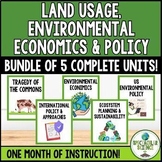Tragedy of the Commons Unit
- PDF
Also included in
- Dive into the complex interplay of human activities and the environment with this comprehensive Land Usage, Environmental Economics and Policy Unit Bundle. Tailored for educators both seasoned and new, this resource aligns seamlessly with the Next Generation Science Standards (NGSS) to elevate yourPrice $32.40Original Price $36.00Save $3.60
- Environmental Science is a laboratory course that is designed to help students understand the complex nature of our environment and make responsible decisions regarding its protection and use. Students will be introduced to problems of land use, human population, environmental health, and sustainabiPrice $400.00Original Price $484.00Save $84.00
Description
Immerse your students in the exploration of shared resources and environmental stewardship with this Tragedy of the Commons Unit. This low-prep unit invites students to delve into the essential question: "What is the tragedy of the commons?"
An indispensable component of any environmental science curriculum, this unit navigates the complex interplay between individual and collective interests in resource management. Students not only grapple with the concept of the tragedy of the commons but also explore real-world examples, fostering a deep understanding of the challenges and solutions associated with sustainable resource use. Equip your students with the knowledge and critical thinking skills needed to address environmental issues and contribute to a more sustainable future.
✎ WHAT'S INCLUDED?
- Unit Pacing Guide
- Tragedy of the Commons Lesson Plan
- Tragedy of the Commons Background Information Worksheet & Answer Key
- Tragedy of the Commons TedEd Video Questions & Answer Key
- Tragedy of the Commons "Smurf" Activity & Answer Key
- Tragedy of the Commons Fishing Lab & Answer Key
- Tragedy of the Commons Quiz & Answer Key
- Tragedy of the Commons Reflection Activity
⚠️ BUNDLE & SAVE!⚠️ Save 10% on this resource in the Land Usage, Environmental Economics and Policy Unit Bundle!
You Might Also Like...
⭐ Looking for quality resources and time-saving tips for your secondary science classroom?
☑ Follow Spectacular Science on TPT
☑ Subscribe to My Newsletter
☑ Check Out My Blog
☑ Follow Me on Instagram






